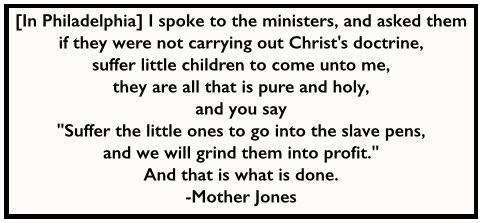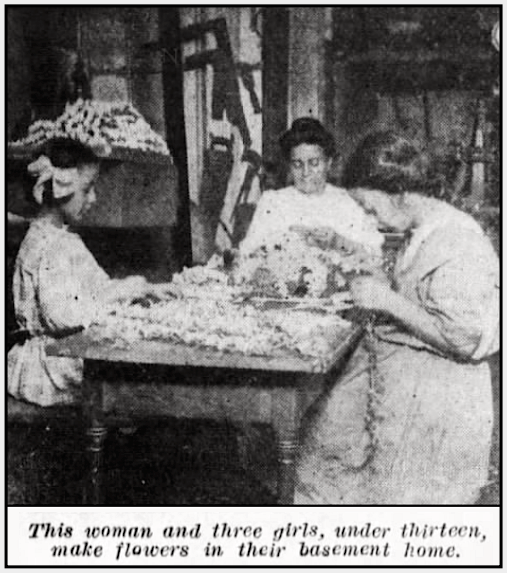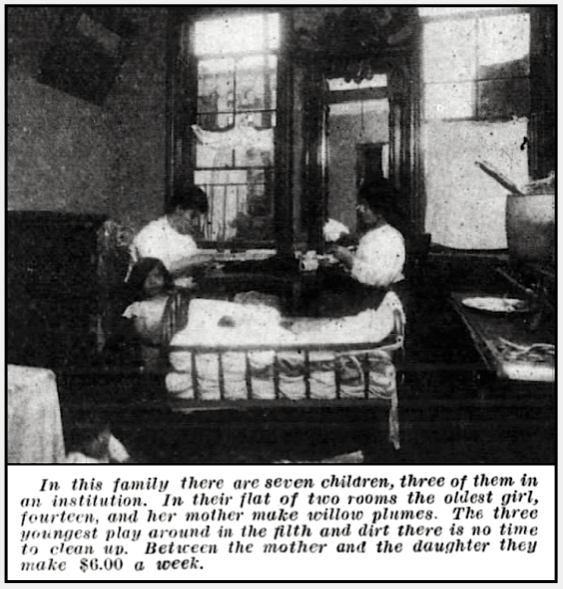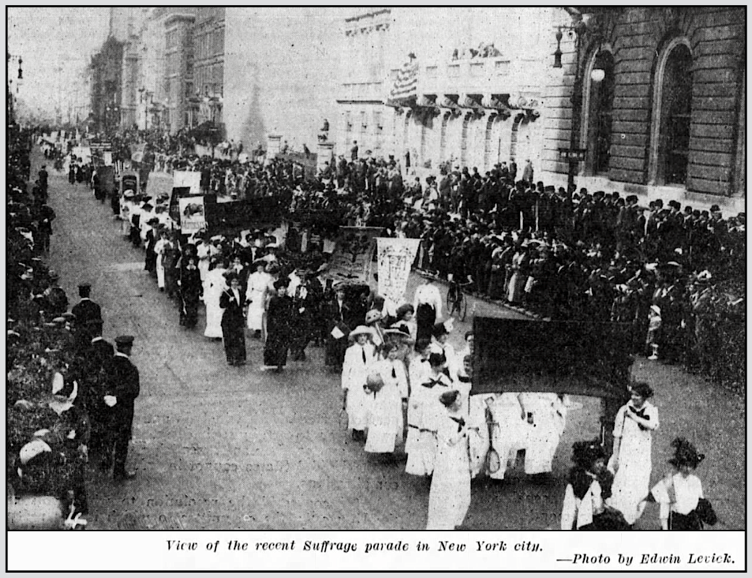 —————
—————
Hellraisers Journal – Friday June 9, 1911
National Consumers’ League Stands with Working Women & Children, Part II
From The Coming Nation of June 3, 1911:
How Women Help Women
By Grace Potter
[Part II of II.]
How Infection is Carried in Clothes
Not the healthiest living nor the strongest constitution is always proof against the germs of scarlet fever, for instance. They are carried readily in clothing, say, an overcoat. Perhaps, even, the man or the woman or children who worked on that overcoat, no one of them had scarlet fever. But the baby of the family where the coat was finished might have had it. The poor haven’t time to care for their sick. They don’t know what ails their children often when they are really very ill. A doctor costs money. It costs much time, which is the same as money to them, to take the little one to a dispensary and wait through hours of weary impatience for attention. Perhaps, too, their child would be taken from them and put in a hospital. And the poor have a reasonable dread of hospitals. So when the babies are taken sick they often go through a disease like diphtheria, tonsillitis, or scarlet fever, without anyone knowing what is the matter.
The little one has to be kept in the same room where the work is going on. It is the least dark room of the two or three or four in their flat. When the baby is picked up for the scant attention which is all that a tenement mother with the tenderest mother feelings in the world can give, the baby leaves infection upon its mother’s dress and the infection is the next moment transmitted to the coat mother is working with. The coat when done is carefully folded, taken back to the shop, later shipped to St. Paul, perhaps, and there bought by a prosperous business man.
How Disease Links the Rich and Poor
When he comes home this business man picks up his baby and hugs her fondly. She is sick with scarlet fever in a few days. The family does all that can be done. And between the anxious watches over their pet, they ask each other, “How could she ever have caught scarlet fever when we are so careful of her?” And maybe with all that it is possible to do in the way of medical care and the attention that a white-robed trained nurse can give, the little girl dies. Won’t that broken-hearted father in St. Paul, Minn., have a new conception of social ties, don’t you think, when he learns why his child was stricken?
The Consumers’ League label is to be found on underwear of all grades, cheap, medium and fine, on corsets, flannelette gowns, dressing jackets, aprons, tea-gowns, wash suits, shirt-waist suits, tub dresses, petticoats, stocking supporters, bathing suits, gymnasium suits, lace and silk waists, kimonos and house gowns.
One of the industries carried on very largely by child and women workers in the dark, unhealthy tenement rooms, is flower making. Parts of the work are done almost entirely by children. Laugh or cry, just as you can. But remember when you buy your Easter hat, milady, that the lilies (typical of purity, aren’t they?) or the roses (joy?) which are to set off your pretty face, were made in dark, filthy rooms by unhappy children. Forget, if you can, that the Christ whose Easter your hat is supposed to honor, said anything about little children coming to him. And remember instead that the poor we always have with us. May be that will somehow make your hat Easter-like. For its lilies are washed white with babies’ tears. And its roses drip red with babies’ blood.
You’d realize this if you looked at the exhibit pictures which the Consumers’ League can show. The pictures were taken from the very rooms where these very children work at flower-making year after year. Not for many years, though. They go to hospitals or sanitariums or the grave, a good many of them, before they grow up, so statistics say.
For making rose-clusters (the lovely, dainty, nodding kind, some of them buds, some half-blown) children get paid one cent for twelve bunches. There are twelve flowers in a bunch. It takes three-quarters of a minute to make one rose. The constant use of certain delicate muscles of the palm gives the children cruel, torturing pain in their hands. It makes them nervous. For winding green cloth about the stem of roses children of kindergarten age are employed, those of four and five working till they fall asleep from exhaustion. Children make violets, too. They are paid four cents a gross. That is less than one cent for thirty violets.
Among the spectators at the exhibit not all express sympathy with the League’s work.
One day a rich woman came in and slowly laying aside her sable coat, put up her lorgnette and deigned to look wearily at the photographs. Down one side of the room, across the end and up the other side she went, looking at all the pictures. She came up to the demonstrator, Miss Treby Moore, when she was through.
“Do you know,” she said, “I have a solution for all this matter which would settle the question of child workers in the tenements once and for all?”
“Well,” said Miss Moore, “you are just the person we would like to hear from. We have been at the question many years. What do you suggest?”
“These people,” the woman indicated with a sweep of her hand the pictures she had been viewing, “they should not be allowed to have children at all, you know. There should be a law against it.”
Miss Moore looked at the woman in amazement, but she evidently was quite sincere in what she said, for she went on complacently.
“If that didn’t work, why, then, they should be prevented from marrying. I’m sure the whole sweat-work problem would then disappear.”
A well-dressed man with a hard face came to the exhibit one day. With him was a second man. The hard-faced man looked with expressions of great pleasure at the pictures of the child workers. “That’s great,” he said, rubbing his hands. “That’s just great! I’m glad to see them making the children work.”
He passed on to other photographs and again said, gleefully:
“Now this just suits me; I never saw anything better in my life than these boys and girls getting down to business.”
His companion made no comment. Miss Moore had heard what the man said and as he neared the door to go out she spoke to him.
“Why do you like to see children working?” she asked.
“Because,” said the man, “I like to walk on the streets without having a mob of children all about. And work keeps them out of mischief, too.”
“But working when they are growing prevents full development,” said Miss Moore. “The children get sick and have to be sent to hospitals and sanitariums and asylums often because they had to work so young.“
“Well,” said the man coolly, “it’s easier to take care of the poor in such places than in jails or than to have them grow up pugnacious and full of fight as some of these strikers are. They make lots of trouble then. If they had had to work hard when they were young they’d be docile and do as their bosses tell them when they were grown up. Yes, I like to see children made to work hard. I’m always glad to give money to hospitals and such places to take care of the sick, but I wouldn’t give a cent to any society that wants to keep children on the streets fooling their time away.”
While the standard wage fixed by the League in their requirements for a Fair House is only six dollars a week, they have learned by their last investigations that that is not enough to keep a woman in some of the largest cities in the United States. So they are going to begin a campaign for establishing minimum wages to be gauged by living conditions in different cities. At the International Council of Consumers’ Leagues held in Geneva, Switzerland, this legislation was advised as necessary.
One of the chief ways in which the League has tried to better conditions for working women has been through the enactment of uniform labor laws throughout the United States. While in Massachusetts the laws are against women working long hours, in some states there is no provision at all made in regard to the matter.
A law passed in Illinois prohibiting the employment of women more than ten hours a day was rendered nil by an injunction restraining the officials of the state from enforcing the newly enacted statute. A committee from the Consumers’ League arranged for the gratuitous services of the distinguished Louis Brandeis, of Boston, in defense of the case before the Supreme Court. Mr. W. C. Calhoun, then newly appointed minister to China, was also available through the American Association for Labor Legislation. A favorable decision as to the ten-hour law handed down in April, 1910, is said to free from overstrain 30,000 women workers. Copies of the brief prepared in defense of the Illinois law have been useful in several other states where attempts were made to thwart decent laws being put into effect.
The decision of the Supreme Court of Illinois, delivered by Mr. Justice Hand, contains the following:
It is known to all men (and what we know as men we cannot claim to be ignorant of as judges) that woman’s physical structure and the performance of physical functions, place her at great disadvantage in the battle of life; that while a man can work for more than ten hours a day without injury to himself, a woman, especially when the burdens of motherhood are upon her, cannot; that while a man can work standing upon his feet for more than ten hours a day, day after day without injury to himself, a woman cannot, and that to require a woman to stand upon her feet for more than ten hours in any one day and perform severe manual labor while thus standing, has the effect to impair her health, and that as weakly and sickly women cannot be the mothers of vigorous children, it is of the greatest importance to the public that the state take such measures as may be necessary to protect its women from the consequences induced by long continued manual labor in those occupations which tend to break them down physically. It would, therefore, seem obvious that legislation which limits the number of hours which women . . . shall be permitted to work would tend to preserve the health of women and induce the production of vigorous offspring by them and would directly conduce to the health, morals and general welfare of the public.
Best of all, the League says, is its answer to the objection sometimes made, that taking away tenement home-work would rob the poor of their only means of existence. Here is their answer:
The time when individual effort could pay in the manufacturing world is over. The time for all such work to be done by organized effort has arrived. It is only prolonging the pain of transition to allow a man and his family in a foul tenement flat to speed themselves up to competition with the best machinery operated in well-lighted, well-ventilated factories where all the requirements of the factory laws which look to the health and comfort of the workers are observed.
Which sounds rather well, from a welfare organization which makes no pretense at revolutionary teaching?
—————
[Emphasis added.]
~~~~~~~~~~~~~~~~~~~~
SOURCES & IMAGES
Mother Jones Quote, CIR May 14, 1915
https://play.google.com/books/reader?id=PeweAQAAMAAJ&printsec=frontcover&output=reader&hl=en&pg=GBS.PA10634
The Coming Nation
(Girard, Kansas)
-June 3, 1911
https://www.marxists.org/history/usa/pubs/coming-nation/110603-comingnation-w038.pdf
See also:
Hellraisers Journal – Thursday June 8, 1911
The National Consumers’ League Stands with Working Women and Children, Part I
Administration of Justice in the United States…
American Academy of Political and Social Science, 1910
(Search: “American Association for Labor Legislation”)
https://books.google.com/books?id=fug1AQAAMAAJ
~~~~~~~~~~~~~~~~~~~~~~~~~~~~~~~~~~~~~~~~
Working Girl Blues – Barefoot Duo
Lyrics Hazel Dickens



